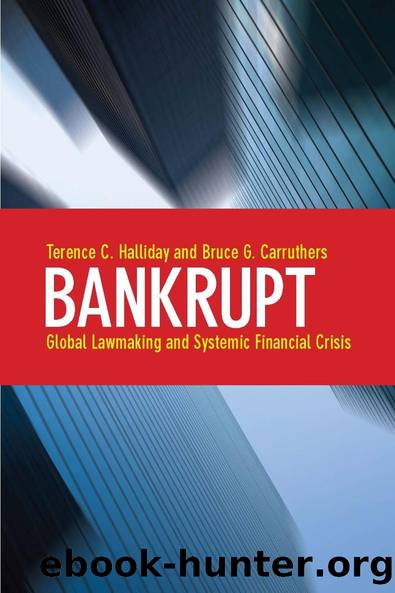Bankrupt by Terence C. Halliday Bruce G. Carruthers

Author:Terence C. Halliday, Bruce G. Carruthers [Terence C. Halliday, Bruce G. Carruthers]
Language: eng
Format: epub
ISBN: 9780804760751
Barnesnoble:
Publisher: Stanford University Press
Published: 2009-04-20T00:00:00+00:00
Bankruptcy Reforms and Institutional Restructurings
Viewed from organizational and institutional perspectives, the Crisis precipitated three widening circles of restructuring in which bankruptcy reforms were implicated. In its narrowest sense, the interplay between international institutions and the Korean government over insolvency reforms involved ways to restructure corporations, or in Nam and Ohâs (2000) terms, design effective âexit mechanismsâ for ailing firms. After the Crisis the Governmentâs policy toward restructuring turned on a classification of all firms into a pyramid of relative impact on the economy or industrial sectors. The largest five chaebols it treated individually in the Big Deals through complex negotiations that divested and merged corporate groups to save them and their bankers. The next layer in the pyramid, chaebols ranging in size from below the top five down to approximately the top eighty, and then to almost one thousand companies above a 50 billion won debt level, it sought to restructure through out-of-court bank accords and later through the Corporate Restructuring Promotion Act, itself essentially an out-of-court procedure. At the lowest level of the pyramid, the GOK was prepared to consign to the courts all midsized and small companies if out-of-court corporate restructurings had not done their job.49 The out-of-court restructurings were designed to be handled primarily by bankers and the largest domestic creditors. They principally involved financial and not operational restructuring (Mako 2002). And they anticipated little cooperation from debtor-managers, shareholders, labor, or trade creditors. As MOFE was to industry, banks were to corporate lenders.
Restructuring might also occur within the courts through the mechanisms of reorganization. The general direction of reforms pushed court reorganizations in a more cooperative direction among the parties to bankruptcy, with incentives for owners and managers to use legal protections, for creditors to negotiate plans with debtors and trustees, and for all parties to expect participation and protection by the court. If none of this worked, then the ultimate exit mechanism was the sale of the firm as a going concern or its breakup into whatever assets still retained value.
The IFIs and Government also recognized that restructuring of the financial sector, not least commercial banking, was critical in its own right and a necessary condition of effective corporate restructuring. In substantial part, the insolvency reforms were effectively banking reforms. The Government had established a powerful and unified financial regulatory body, the Financial Supervisory Commission, and given it extensive powers of bank supervision through its operational arm, the Financial Supervisory Service.50 The workout accords, and especially, the Corporate Restructuring Promotion Act, required that banks create internal monitoring protocols and workout units that would constantly maintain a vigilant eye over the finances of the companies that borrowed from them. Just as corporate managers now expected bankers to be scrutinizing them more carefully, so bankers anticipated that regulators would be watching them far more closely. Hence the financial and corporate regulatory packages of the IFIs and Government were integrally connected. The health of each depended on the other.
In a wider sense, the story of insolvency reform is an element of a more consequential projectâthe restructuring of the Korean state.
Download
This site does not store any files on its server. We only index and link to content provided by other sites. Please contact the content providers to delete copyright contents if any and email us, we'll remove relevant links or contents immediately.
The Social Psychology of Inequality by Unknown(2313)
The Plant Paradox by Dr. Steven R. Gundry M.D(2047)
The Writing on the Wall by Anselm Jappe(1761)
Working for Yourself by J.D. (Nolo) Stephen Fishman(1480)
Every Landlord's Legal Guide by Janet Portman & Stewart Marcia & Ralph Warner(1329)
The First 20 Hours: How to Learn Anything ... Fast by Kaufman Josh(1309)
ADHD on Trial by Michael Gordon(1242)
Decisive by Chip Heath(1202)
Drafting Contracts: How and Why Lawyers Do What They Do, Second Edition by Stark Tina L(1175)
Working for Yourself by Stephen Fishman J.D. (Nolo)(1141)
The Economist Aug 8th 2015 by The Economist(1124)
Restitution by Restitution(1116)
The Economist Aug 29th 2015 by The Economist(1099)
A Practical Guide to International Arbitration in London by Hilary Heilbron(1085)
The Lord of the Rings: The Fellowship of the Ring, the Two Towers, the Return of the King by J. R. R. Tolkien(1084)
Intellectual Property Strategy by John Palfrey(1083)
Collusion by Luke Harding(1046)
Persuasion by Owner(1018)
Chapter 1 by Owner(952)
